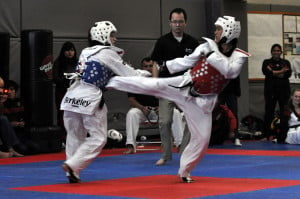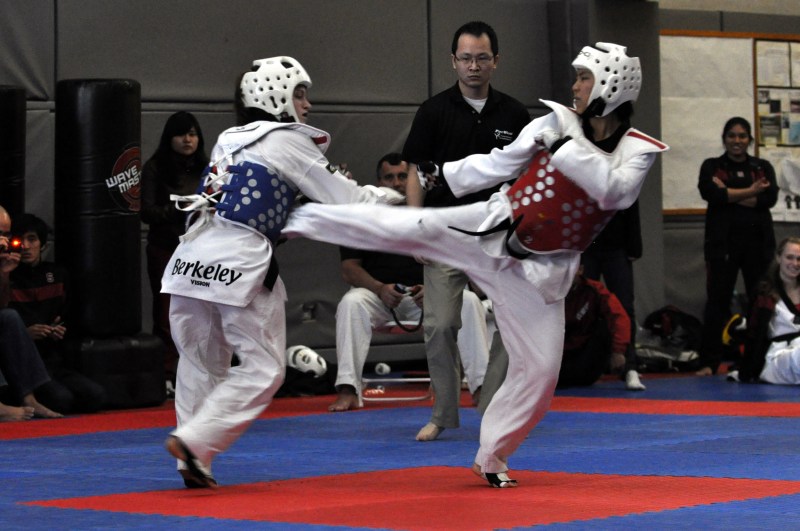Fully equipped with chest protectors, foot protectors, shin guards, arm guards, mouthpieces, head protectors — and cups just in case — these white-clad martial artists throw pin-straight, razor-sharp line kicks into the air faster than their yelled kiaps ring out.
***
Taekwondo has approximately 30 people in its club and an additional 15 people on the team. About half of them came in with experience already, but many people also started out as white belts or first tried out other martial arts. For example, coterm Kaz Gunning, currently president of the club, started out with karate and tried out different martial arts like muay thai before eventually sticking with taekwondo because of its competitiveness and the high level he could compete at.
While Stanford Taekwondo is a club sport, the student-athletes enjoy many of the same resources as varsity athletes. Tim Ghormley, who has been coaching the club since January 2004, praised the Stanford administration for all the support that taekwondo has gotten, drawing comparisons with his time coaching at Cal State University.

“It’s a really positive environment,” Ghormley said. “We’re lucky that we have a very supportive administration and that’s a little unusual from what I’m used to.”
The team also enjoys a great number of award-winning coaches. Ghormley himself was named National Coach of the Year in 2009, and Kent Kitagawa, now the head sparring coach for Stanford, spent two years as head coach of the U.S. National Collegiate Team. Additionally, Reynaldo Soriano, the assistant sparring coach, is a former member on the Australian National Team.
***
Stanford Taekwondo holds seven practices a week that last at least an hour and a half. Some members also attend private training sessions to work on personal goals and skills.
Training is taken very seriously — even while balancing a heavy computer science major course load, sophomore Haley Kong trains practically every day.
“Training taekwondo translates into what you do in life, so just like how you focus with school work, you have to focus with every millisecond in taekwondo because every decision you make can change the outcome in a match,” Kong said.
“We have goals each week and have seminars with our coaches to discuss what we want to improve on,” said John Do ’12, who has been with Stanford Taekwondo since his freshman year.
Do also mentioned cross-training, including plyometric workouts after training that target different muscle groups. “We work on fast-twitch muscles, like a sprinter, because we need to engage and throw out fast, precise kicks.”
Every year, Stanford Taekwondo takes part in several competitions, including the PacWest Conference, where it faces seven other West Coast colleges, and the National Collegiate Taekwondo Championships. Some members of the team also compete outside of the collegiate circuit in competitions such as state championships, the U.S. Open and as well as international contests.
Competitions are made up of both poomsae and sparring events. Poomsae can be thought of as a choreographed set of moves in which the competitor has to move with precision, style and technique that judges score on, while sparring is scored by electronic protective gear that counts how many kicks are landed on certain regions of the body. Earlier this winter, Stanford tied for first place with UC-Davis at the PacWest Conference, and in the second week of spring quarter, Stanford won the championship division at nationals in the Colorado Springs Olympic Training Center.
“We go there and we’re a group of Spartans,” Do said. “We don’t come in with a lot of people compared to other teams — they just get to go up to the podium just by sheer numbers. And we were able to place by just three people going to compete.”
“Well for one thing let just say how proud I am,” Ghormley said. “They work really hard just like any other team. Lots of hours of practice and sacrifice. [Winning] definitely solidified my position nationally as a part of a quality program that produces athletes as well as one of the largest recreational sports on campus.”
***
Physical attributes, endurance, speed and flexibility are all important to the martial artist. However, mental acuity, strategy and execution are just as significant.
“To me, what a taekwondo athlete should encompass is one, on the physical side of things, training your body hard, but then the other part is the philosophy behind whatever you do. You aren’t just kicking for the sake of kicking. You have a reason,” Do explained. “What separates some from others is that they strive for excellence in not just themselves but also in others around them, as a team building synergy. That to me is the excellent taekwondo [athlete].”
Respect is also paid to the roots and tradition of taekwondo. Before training, all members are expected to bow into the ring and pay respect to the coaches, as well as to the judges during competition.
“It’s a martial sport,” Ghormley said, “with all the components of a regular competitive sport and the underpinning nature of martial arts. Everyone adapts to their own strengths and weaknesses, and as a coach you have to determine all that.”
Kong remarked on how everyone’s kiap is extremely unique to each individual. “I also love how when people are wearing their headgear and shoulder protectors and everything, you can’t identify them but then within five seconds of watching them fight, you can tell who they are.”
***
Taekwondo is not only open to Stanford as a whole, but also to the community, and the club hosts opportunities for locals from outside of Stanford. In fact, Stanford Taekwondo hosts two junior scrimmages, in which clubs from all over the Bay Area (some clubs coming in from Oregon, Nevada and even Alaska) are invited to an open tournament competition that the Stanford team judges.
The club also collaborates with Team-M, a demonstration team based in San Jose. Team-M’s head poomsae coach, Huy Nguyen, recently named Coach of the Year, helps the Stanford team with its poomsae. As poomsae has become more popular during competitions, this relationship with the local group has definitely given it an advantage.
Additionally, the club has close ties with teams abroad, contributing to an even more comprehensive and international experience for its members, and also participates in exchange programs with other national teams. Members from teams based in Taiwan, Mexico or Cuba have been invited to travel to Stanford to train on the Farm, and athletes from Stanford have also trained elsewhere.
Stanford Taekwondo had also hired two interns from Korea to help the club train, and during the practices, it’s evident that the student-athletes really appreciate the extra input.
“They’re world champions,” said William Nguyen, a graduate student who has been part of the team for two years. “It’s pretty cool having a foreign national champion come to help us train so that we get better.”
“They’re just that much above us, and they’re [people] I aspire towards. As our coaches, even though you can tell that there’s a language barrier and it’s hard to communicate with them, they really care about us and how we do as individuals.”
***
For many of the club members however, taekwondo is not just about the sport. Stanford Taekwondo hosts many internal social events and many members agree that they’ve met their best friends on the training mat.
“People aren’t just interested in competition,” Nguyen said. “It’s to have a place where people can come and have a good workout, training and exercise. [The team] is really welcoming, which draws me to [taekwondo]. When I first joined, the people kept me here. I never wanted to ever leave because of taekwondo. It’s made my time at Stanford. I honestly can’t imagine life without taekwondo now.”
Contact Catherine Zaw at czaw13 ‘at’ stanford.edu.
